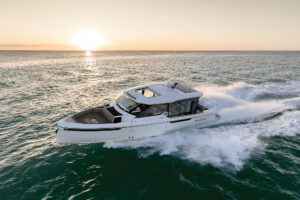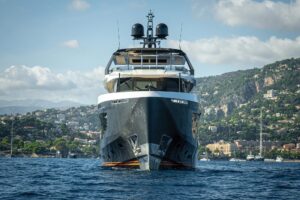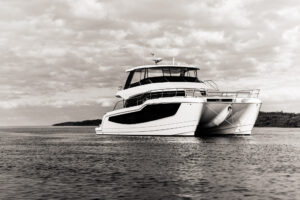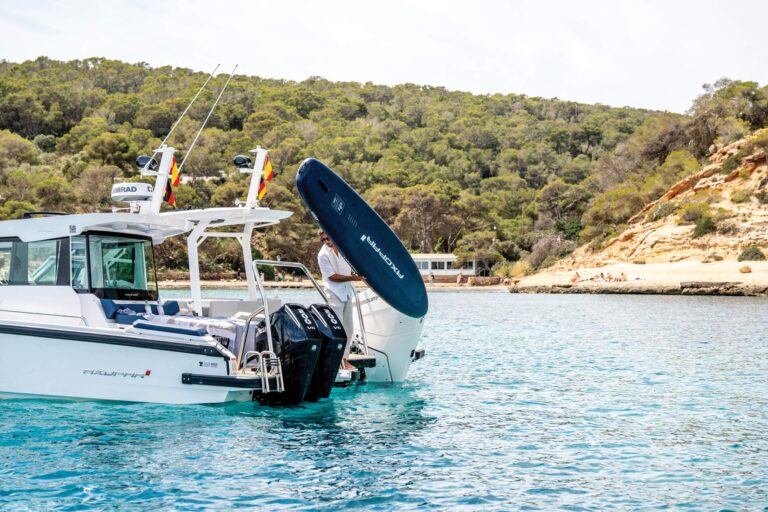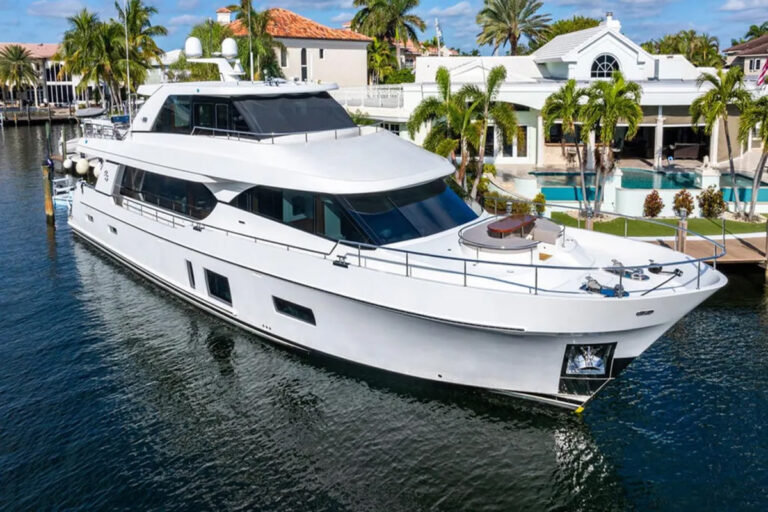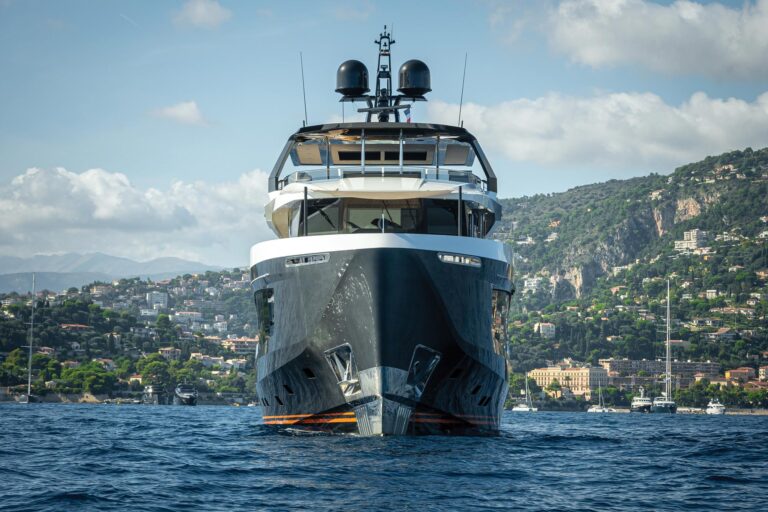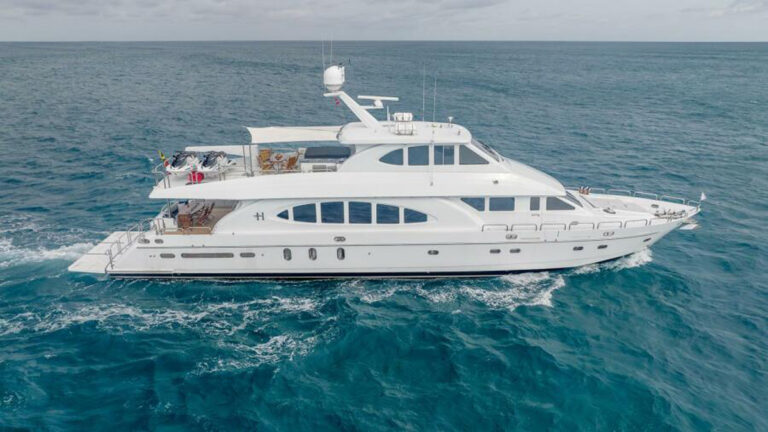Convertibles are best known for fishing, but as their classification suggests, they’ve always had split personalities. When motoryachts were still lumbering along at 18 knots, convertible designs offered cruising yachtsmen a high-performance alternative. Still, the original focus, fishing, has always driven the core of the convertible market and that is a target Viking Yachts has focused on in recent years. For this reason, those who love fish and are serious about catching them will appreciate the builder’s latest effort, the 54 Convertible.
To understand the 54, it is worth revisiting the 1990s when Viking’s product seemed to be going through a metamorphosis. The hump sheer and the boxy house in golden gelcoat were the first to go, followed by the bow scroll and plastic portlights. These features were replaced with a more rakish off-white superstructure set back on a smoother S-curved sheer. The result was pleasing and continued to evolve. By the late 1990s, some convertible builders had taken inspiration from the European designs that were beginning to draw the attention of performance-minded cruisers. Viking, however, kept its eye on the growing market for custom tournament sportfishers. These designs tended to be tastefully conservative in terms of styling and arrangement, but over the top in terms of features and innovation-so, too, is the new 54.
To those familiar with Viking, the knowledgeable eye will detect that her lines have been tweaked and refined. Her house setback, rake and curves have been penned in ideal proportions. She is pleasantly free of unnecessary “design cues” or “styling elements;” her form has purpose. Her sheerlines and stem rake suggest speed without effort. While added length overall typically enhances the positive features of a boat, it is clear that 54 feet was all the Viking design team needed. To my eye, she is one of the best-looking boats the builder has launched to date.
Although 54 feet is barely midsize in today’s convertible market, it is near perfect in terms of serious fishing. The 54’s cockpit dimensions are tailored for a full-size chair and you don’t need track shoes to reach a bent rod. Beneath her teak-sheathed cockpit sole is plenty of room for a live well and an insulated fish box plumbed to an ice machine. A mezzanine level with a settee includes a stowage locker and a freezer that is compartmentalized to help keep track of bait. A refrigerated drink box is hidden beneath the entryway to the saloon. Our test boat’s transom door was for fish only and had no lift gate; however, if you like going overboard on occasion, a lift gate is standard.
A ladder leads above to the bridge, which is arranged tournament style with Murray Products helm and companion seating and a flip-back observer seat. A varnished teak helm pod is fitted with single-lever stainless steel controls, and an impressive collection of electronics includes four large displays mounted in the console under clear acrylic covers. Our test boat had a full tower and the fiberglass hardtop had a hidden teaser-reel pocket and a molded-in overhead electronics box. While the engine electronic displays were mounted in this location, I would opt for a console location-it’s easier on the neck. I might also add redundant analog gauges under glass on the pod for tradition’s sake. Bench seating forward is home to a freezer and a stowage compartment large enough for a six-man offshore life raft. Sight lines forward across the bow and below to the cockpit are ideal. Following the tournament theme our test boat was fitted with a low-profile bow rail and the anchor was stashed in a foredeck locker. (Sensible bow rails and anchors dangling from pulpits are considered gauche by the tournament set. Viking offers both as standard equipment for the less fashion conscious.)
Push an anodized aluminum button in the cockpit and the saloon door slides open effortlessly. The layout is traditional convertible fare with saloon aft and open galley and adjacent dinette forward. Stowage beneath the L-shaped settee is easy to access thanks to a clever design that tips the seat and seatback up as one unit. The saloon table has a varnished burl wood top and an ice machine is a few steps away. A bulkhead-mounted 42-inch flat-panel TV can be eyeballed from almost anywhere in the saloon. The galley is finished with granite countertops and is equipped with undercounter Sub-Zero refrigeration, a cooktop, a microwave/convection oven and space for a trash compactor or dishwasher. The standard three-stateroom two-head layout includes a midship master with a queen island berth and a private head. A midship guest stateroom has upper and lower berths and the forward guest/VIP stateroom has a queen island berth. Both guest staterooms have private access to the second head that is also home to a washer/dryer. An alternate arrangement substitutes the forward queen for crossover single and double berths.
The 54’s interior is finished with a processed honey teak that Viking has used for some time. Clearly the boatbuilder has mastered its application; the consistent grain pattern has a flawless high-gloss finish. The soft goods and fixtures are in line with Viking’s high standard.
One of the 54’s most impressive features is her machinery space. Accessible from the cockpit, the area is thoughtfully arranged and finished in custom yacht fashion. I found plenty of room to move about even with the 12-cylinder MANs and support systems for just about every option available. There is nearly standing headroom on centerline and space enough to move outboard forward of the engines. The area is bathed in high-gloss Awlgrip, including pumps and through-hulls, although coating the latter for some reason appears on the option list. A lubricating oil-change system is plumbed to the engines, transmissions and generators and all can be tapped via a quick disconnect fitting in the cockpit-very thoughtful. Attention to detail is common throughout the 54’s bilge areas, very impressive work for a production builder.
The 54 is built with a combination of stitched and woven reinforcements and a custom blended polyester resin. The bottom is supported by a fiberglass stringer system and foam-cored bulkheads. Balsa coring is used to stiffen the hull sides, areas of the bottom and the superstructure. Lightweight core materials are also used in the construction of the interior. Fuel tanks are built of resin-infused fiberglass and precision fit to the hull’s interior, which helps maintain a low center of gravity. The main tank under the cockpit carries the bulk of the 54’s fuel load, and an auxiliary tank forward is plumbed to the main tank with a transfer pump. I recommend opting for a second pump for redundancy. The 54’s engines are mounted to steel I-beams that are fixed to foundations on the compartment bulkhead aft and to a stout web frame forward. While Viking did not invent this mounting system, the company seems to have perfected it with the goal of reducing installation headaches and vibration. Exhaust is funneled efficiently out the bottom at speed and through a transom-side bypass at idle.
Our sea trial on the 54 was conducted offshore of Palm Beach. Brilliant blue skies, a light northeast breeze and a strong sailfish bite made it hard to remain on task, but work is work. The 54 has a new hull form with slight convexity forward and 15 degrees of deadrise at the transom. She accelerated to a maximum speed of 40.1 knots (2360 rpm) in a bit more than 40 seconds. This is a few more turns than MAN recommends and as we were nearly fully loaded and fitted with a tower, I suspect tweaking the wheels could put a bit more horsepower into the water and might add slightly to the top end. At 2100 rpm I noted a speed of 36.2 knots and the MAN electronics indicated a fuel burn of 126 gallons per hour. The 54 rises quickly to speed and the water breaks cleanly at her chine. She has the feel and response of a light, fast boat. Applying the trim tabs did not seem to have much effect and perhaps adding a bit more tab surface or travel might be useful for engaging head seas. Her propeller pockets seemed to work splendidly without compromise and they limit the 54’s draft to five feet two inches, which makes most of the Bahamas accessible. With her standard fuel capacity of 1,445 gallons, this will be no problem. Those planning on fishing Mexico will want to choose the 1,745-gallon fuel capacity that is offered as an option.
While some boatbuilders keep things interesting by cycling shapes and colors, Viking seems focused on refining its products and perusing an ever-higher standard. In this effort, Viking has kept its ear tuned to the dock and been able to keep pace with the latest thinking on the tournament trail. Continuing to kick things up a notch has its costs. Our fully equipped test boat tipped the scales at $2,357,794. Those who shop high-end, high-performance tournament boats will find this a fair number considering the 54’s premium presentation. Add Viking’s legendary customer service and the 54 seems a smart buy.
Contact: Viking Yachts; www.vikingyachts.com


